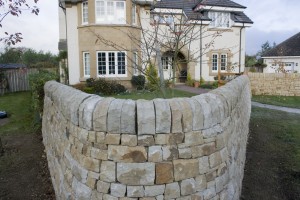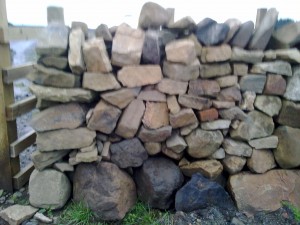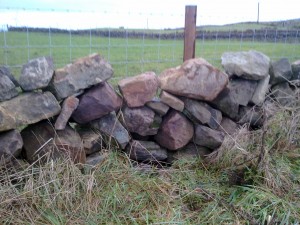How not to build a dry stone wall
Building dry stone walls is dead easy. You basically place one stone on top of another, or as our American cousins like to say, you “stack ’em”. And it really is that simple. Except that you need to make sure that you cover your joins – “one on two; two on one” as the old-timers used to say. And you need to ensure your foundations are strong. And that the line is straight. And that there is sufficient hearting – “what is hearting?” Oh, and put in throughs (remind me what they are again???). And make sure the copes are pinned and tight. And don’t forget the batter. Batter? Eh?

A well built dry stone wall
So, lets recap. Building dry stone walls is dead easy. If you know how to do it properly in the first place, that is. Doing it well is another matter entirely. It takes practice. Years of practice to build up your skills. The example here is of a properly built wall – straight lines, decent batter, tight copes, throughs, all joins covered etc etc.
So why is it that construction companies and main contractors continually feel that they can do they work themselves?
The images below are from a walling job that I didn’t get as the main contractor felt that my professional’s price was too much. They said that their own guys could do it just as well. These images of a wall which is less than 2 years old proves that you get what you pay for. Dry stone walling is a skilled profession. And like any job worth doing, get someone who knows how to do it in order to do it properly.
This is the worst cheek-end that I have ever seen. It is wrong on so many counts. From the foundations to copes, there is nothing right with this.
And this is meant to be a free-standing section. It literally is a pile of stones. How anyone could think that this was acceptable work, I don’t know. Perhaps they felt that having a fence behind would make this look rustic? This piece of wall joins in with an existing section of stone wall, that whilst it has seen better days, at least has some form to it. The use of stone is so poor. Nothing is locked together and everything moves. Horrible.



Truely horrible , and the customer paid for that ? well its a notable landmark, ” you turn left at the xroads, go along two miles till you come to a really crap wall- your there ! ” As they say, ‘ you get what you pay for’. I am sure something would be said if it was brick \ blockwork !
tim
Loose walling served a purpose as a deterent to livestock before wire fencing was available, although the wall above looks to low to be functional. A loose wall can be built many times faster by a skilled waller than a wall which is meant primarily as a decorative boundry marker. The farmer would have touched up his walls every year or so, basically walking boundries replacing fallen stones. Boundry ditches are a different type of stonework to domestic/public works although in either case a grasp of the relevant environmental conditions is required.
I think that the “loose” walling style you refer to is as much a reflection on the type of stone available as to the quality of the work. I’ve built and rebuilt many metres of Border’s farm walling where the stone – a rough and irregular stone – precludes a “tight” style of build. Given that much of this walling is on hill-farm land where sheep predominate, the style of walling looks loose but is actually very strong. The gaps between some of the stones, especially the copes, allows daylight through and so deters sheep from leaping over.
Unfortunately not many farmers now have the time or the inclination to make running repairs, nor do the rates of pay available to wallers encourage them to undertake the repairs. Hence we get fences and gates to block gaps.
I also disagree with you about the speed. Depending on the stone, a competent waller would expect to build between 1.5 and 2.5 liner metres of wall (1.4m tall) a day. Small stone takes longer than big chunky stone. I don’t think any competent waller would say that they build loosely. Every stone must be tight, and walls must be well built. A wall that is thrown together for speed will only fall down in time. There is no difference in the way I repair farm wall gaps or fancy retaining walls in private clients gardens.
The walling in the example pictures I posted is actually just very poor quality work. I know this as I went to price this job. There were no walls in place, and the walls that were built were not to be livestock proof.
Good to know you still think of us stackers over here! Ha! I feel your pain dude. I’ve lost many a job, only to come back and see a wall much like the one you have in the picture here. A friend and I have talked about starting a stone wall death pool! You in? Keep on stackin’!
It’s annoying to think that someone got paid to build it. What can you do but keep on trying to promote proper standards to those people who commission work.
Stacked, dry-laid or dry stone walled – it’s all the same as long as it’s built properly.
Yes, but all 3 are standing.
i guess its the same the world over , unless you have a licencing system or have to garauntee your workmanship for a defined period your going to get this kind of crap
Those professional members of the DSWA have a requirement to at least maintain the standards specified by their level of certification. And the DSWA is there as an arbitrator for clients to go if work is poor. And usually main contractors retain a portion of the subbies payment to cover repairs. In this case since I think the work was done by the main contractor, there is no retention fee. But whoever signed off the work must have been able to look at the finished wall and go “it’s not very good”. Surely??
Hi Jason,
Love your work.
Unfortunately, you’re not the only one who get “you’re too expensive”…
I think the problem lies in lack of education. As Tim Sloper said: “I am sure something would be said if it was brick \ blockwork !”
People see bad examples of modern stonework (crazy paving on the wall for instance) as acceptable, more so, they love it! Therefore, I give two things to every customer, regardless I’m hired or not, – my business card (nothing unusual there) and a link to a video to watch when there’s nothing else to do: http://www.viddler.com/explore/ncpttmedia/videos/12/
Some tradesmen argue with me saying that I won’t be hired if I will teach my customers how to DIY. But as you mentioned earlier, “…If you know how to do it properly in the first place, that is. Doing it well is another matter entirely. It takes practice. Years of practice to build up your skills.”
Best regards
Alex
Hi Alex, thanks for the video. That was funny seeing Paul Webley, the Master Craftsman from the UK, in it! I think it is a great thing that you show potential clients how a wall should be built – at the very least they’ll have some expectations of what they are paying for.
I think in the case of the job I highlighted, the main contractor just wanted something thrown up to replace old walls that had been taken down. It’s a shame that much of what was built will be fallen down by next year.
Jason, its a heap of stone that if it were not for the wooden fence and wire fence has no prayer of keeping in the animals. not to mention its an eyesore even for the inexperienced.
A few masons here in VT have agreed to have an informal meeting about standards, communication, artistry and skills. Our first meeting is in a week on Wednesday. I’m looking forward to it as a place to start a conversation about stone work combating issues like the one you raise here and generally sharing and building one another up. We are meeting at a Stone carving studio in Shelburne VT.
I think you should come.
What time is the meeting Thea? I’d love to come. If you need any pics of this lovely wall to use as an example, I’d be happy to send you some larger versions.